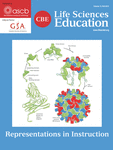Assessment of Student Learning Associated with Tree Thinking in an Undergraduate Introductory Organismal Biology Course
Abstract
Phylogenetic trees provide visual representations of ancestor–descendant relationships, a core concept of evolutionary theory. We introduced “tree thinking” into our introductory organismal biology course (freshman/sophomore majors) to help teach organismal diversity within an evolutionary framework. Our instructional strategy consisted of designing and implementing a set of experiences to help students learn to read, interpret, and manipulate phylogenetic trees, with a particular emphasis on using data to evaluate alternative phylogenetic hypotheses (trees). To assess the outcomes of these learning experiences, we designed and implemented a Phylogeny Assessment Tool (PhAT), an open-ended response instrument that asked students to: 1) map characters on phylogenetic trees; 2) apply an objective criterion to decide which of two trees (alternative hypotheses) is “better”; and 3) demonstrate understanding of phylogenetic trees as depictions of ancestor–descendant relationships. A pre–post test design was used with the PhAT to collect data from students in two consecutive Fall semesters. Students in both semesters made significant gains in their abilities to map characters onto phylogenetic trees and to choose between two alternative hypotheses of relationship (trees) by applying the principle of parsimony (Occam's razor). However, learning gains were much lower in the area of student interpretation of phylogenetic trees as representations of ancestor–descendant relationships.



